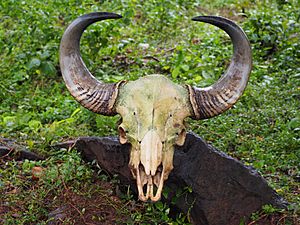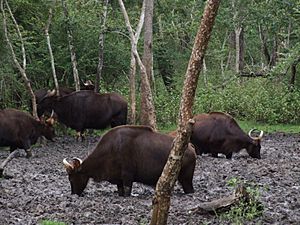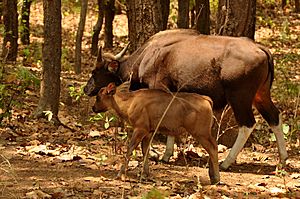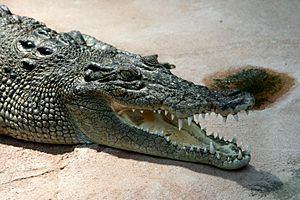Gaur facts for kids
Quick facts for kids Gaur |
|
|---|---|
 |
|
| Bos gaurus | |
| Conservation status | |
| Scientific classification | |
| Kingdom: | |
| Class: | |
| Order: | |
| Family: | |
| Subfamily: | |
| Genus: | |
| Species: |
B. gaurus
|
The Gaur is a large wild animal, a type of bovine (like a cow or bison). It is also known as the Indian bison. Gaurs are the biggest living bovines in the world! They live in South Asia and Southeast Asia.
Since 1986, the gaur has been on the IUCN Red List as a vulnerable animal. This means their numbers are decreasing. But in some places where they are protected, their populations are growing.
The gaur is the tallest type of wild cattle. In Malaysia, the gaur is called seladang. In Myanmar, it's called pyoung. There's also a tamed version of the gaur called 'gayal' or 'mithun'.
Contents
What Does a Gaur Look Like?
Gaurs are very strong and big animals. They have a high, rounded ridge on their forehead between their horns. This ridge sticks out, making a dip in their head shape. They also have a clear ridge along their back.
Their ears are very large. Their tail is short, only reaching their ankles. Older male gaurs have very thin hair on their backs.
Adult male gaurs are dark brown, almost black when they are very old. The top of their head, from their eyes to their neck, is usually grey or dirty white. Their nose area is light-coloured. The lower parts of their legs are pure white or tan. Female gaurs and young males are lighter in colour. Some even have a reddish tint, especially in dry, open areas.
The gaur's shoulders can be about 12 cm (5 inches) higher than their rear. This is because the bones in their upper back are very long. Their hair is short, smooth, and shiny. Their hooves are narrow and pointed.
Gaurs are quite tall. They stand about 142 to 220 cm (4.6 to 7.2 ft) high at the shoulder. Males are usually taller, averaging about 188 cm (6.2 ft). They are also much heavier than females. Females weigh from 440 to 1000 kg (970 to 2200 lb). Males weigh from 588 to 1500 kg (1300 to 3300 lb). Some males in China can weigh over 1200 kg (2600 lb). The Malaysian gaur (seladang) might be even bigger on average than those in India.
Gaurs do not have a loose flap of skin (called a dewlap) under their throat or chest. Both male and female gaurs have horns. The horns grow from the sides of their head and curve upwards. They are flat at the base and curve smoothly. The tips of the horns are black, while the rest is pale green or yellow. These horns can grow to be 60 to 115 cm (24 to 45 inches) long.
Female gaurs are lighter in build and colour than males. Their horns are thinner and stand more upright. The ridge on their forehead is barely noticeable. Young gaurs have smooth, shiny horns. Older males have rough, bumpy horns at the base.
Gaurs are among the largest land animals on Earth. Only elephants, rhinos, hippos, and giraffes are usually heavier. The Asian elephant and Indian rhinoceros live in the same areas as gaurs and are heavier. The gaur is the largest wild bovine alive today.
Where Gaurs Live

Gaurs used to live all over South and Southeast Asia. This included countries like Vietnam, Cambodia, Laos, Thailand, Malaysia, Myanmar, India, Bangladesh, Bhutan, China, and Nepal. But now, their homes are broken up into smaller areas. They are no longer found in Sri Lanka.
Gaurs mostly live in evergreen or semi-evergreen forests. They also live in moist deciduous forests. They prefer hilly areas below 1800 meters (5900 ft). Their homes need to have plenty of water and lots of plants to eat, like grasses, bamboo, shrubs, and trees. They can live from sea level up to at least 2800 meters (9200 ft) high.
In India, there are about 23,000 to 34,000 gaurs. Many live in the Western Ghats in southern India. Large groups of gaurs live in places like Nagarhole National Park and Bandipur National Park.
In Nepal, the gaur population has grown. In Chitwan National Park, their numbers increased from 188 to 368 between 1997 and 2016.
Gaur Habits and Life
When gaurs are not bothered by humans, they are active during the day. But in areas where people disturb them, they become more active at night. In central India, they are most active at night and are rarely seen in the open after 8 AM. During the dry season, gaur herds stay in small areas. When the monsoon rains come, they spread out into the hills. Gaurs need water to drink, but they don't seem to bathe or roll in mud.
In January and February, gaurs live in small groups of 8 to 11 animals, usually with one male. In April or May, more males might join the herd for mating. Males can move between herds and mate with many females. In May or June, males leave the herd. They might form groups of only males or live alone.
Gaur herds travel about 2 to 5 km (1.2 to 3.1 mi) each day. Each herd has a home area that sometimes overlaps with other herds. Sometimes, many herds might join together in groups of 50 or more.
An old female gaur usually leads the herd. Adult males might live alone. During mating season, single males travel widely to find females. Males do not fight seriously over females. Their size is the main way they show who is stronger. Males make a loud, clear mating call that can be heard over 1.6 km (1 mi) away. Gaurs also make a whistling snort as an alarm call and a low moo like a cow.
In some parts of India where humans don't bother them much, gaurs are shy, even though they are big and powerful. If they get scared, they run into the jungle very fast. But in Southeast Asia and South India, where they are used to people, gaurs can be very bold and aggressive. They sometimes go into fields and eat grass next to farm animals. They have even been known to kill farm animals in fights. Male gaurs might charge without warning, especially in summer when the heat and insects make them easily annoyed. To warn their herd of danger, a gaur lets out a high whistle.
What Gaurs Eat
Wild gaurs graze (eat grass) and browse (eat leaves and twigs) on many different plants. They eat more types of plants than any other hoofed animal in India. They especially like the top parts of plants, like leaves, stems, seeds, and flowers of grasses.
Scientists found that gaurs eat 32 different kinds of plants in one park. They eat herbs, young shoots, flowers, and fruits. They really like leaves. What they eat changes with the season. In winter and during the monsoon, they prefer fresh grasses and herbs. But they also eat leaves from shrubs. In summer, they eat the bark of teak trees and the fruit of golden shower trees and cashew trees.
Gaurs spend most of their day eating. They eat the most in the morning (6:30 to 8:30 AM) and late afternoon (5:30 to 6:45 PM). During the hottest part of the day, from 1:30 to 3:30 PM, they rest in the shade of big trees.
They might eat tree bark if their favorite foods are scarce. They also eat bark to get minerals and nutrients they need. Protecting the places where gaurs naturally live is very important for their survival.
Reproduction and Life Cycle
Female gaurs usually have one calf, but sometimes two. The baby grows inside the mother for about 275 days, which is about nine months. This is a few days less than domestic cattle. Calves drink their mother's milk for about 7 to 12 months. Gaurs can start having babies when they are two or three years old. They can breed all year round, but most births happen between December and June. In zoos, a gaur can live up to 30 years.
Natural Enemies
Because gaurs are so big and strong, they have few natural enemies besides humans. Leopards and packs of dholes (wild dogs) sometimes attack young or sick gaurs. However, only tigers and large saltwater crocodiles have been known to kill a full-grown adult gaur. But gaurs and saltwater crocodiles rarely live in the same places anymore. A crocodile would need to be very large (over 3.7 meters or 12 feet long) to attack a healthy male gaur successfully.
Tigers hunt young or weak gaurs. But they have also been seen killing healthy male gaurs weighing at least 1000 kg (2200 lb). When a tiger approaches, adult gaurs in a herd often form a circle around the young ones. This protects the calves from the tiger. Tigers usually rely on surprise attacks. If a gaur herd spots a tiger and stands together like this, the tiger will almost always give up and leave. In one case, a gaur herd in Malaysia surrounded a calf that a tiger had killed. They stopped the tiger from getting to the body. In Nagarahole National Park, a gaur herd sensed a tiger stalking them. They walked towards the tiger in a threatening line, forcing the tiger to retreat.
Gaurs are not as aggressive towards humans as wild water buffaloes.
Dangers to Gaurs
In Laos, gaurs are in great danger from poaching. Poachers hunt them to sell their meat and body parts in other countries. They also hunt them for food for themselves. In the 1990s, Vietnamese poachers especially hunted gaurs because they could sell them for a lot of money.
In Thailand, gaurs are also greatly threatened by poaching. People hunt them to sell their meat and for trophies.
Images for kids
See also
 In Spanish: Gaur para niños
In Spanish: Gaur para niños














